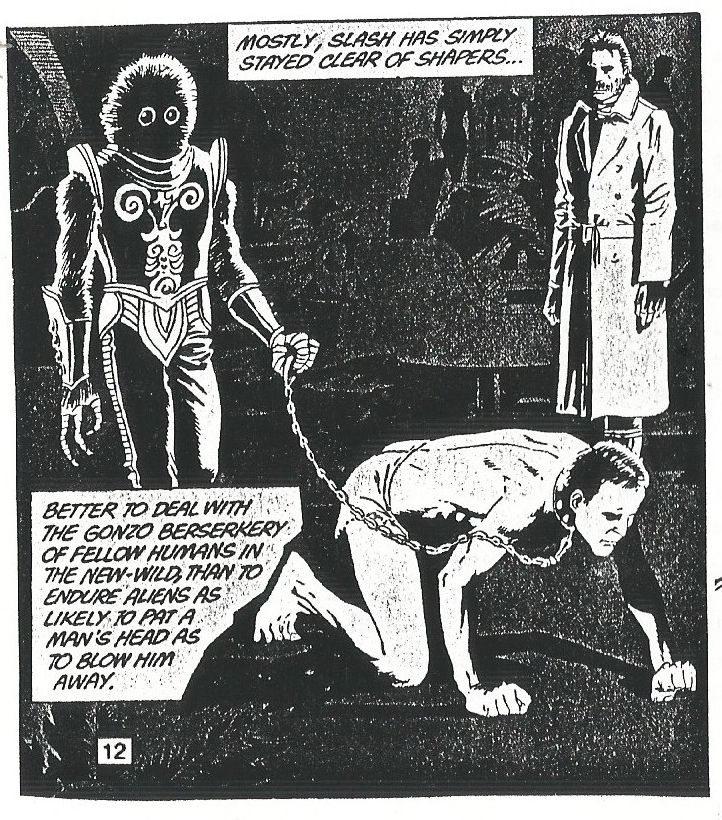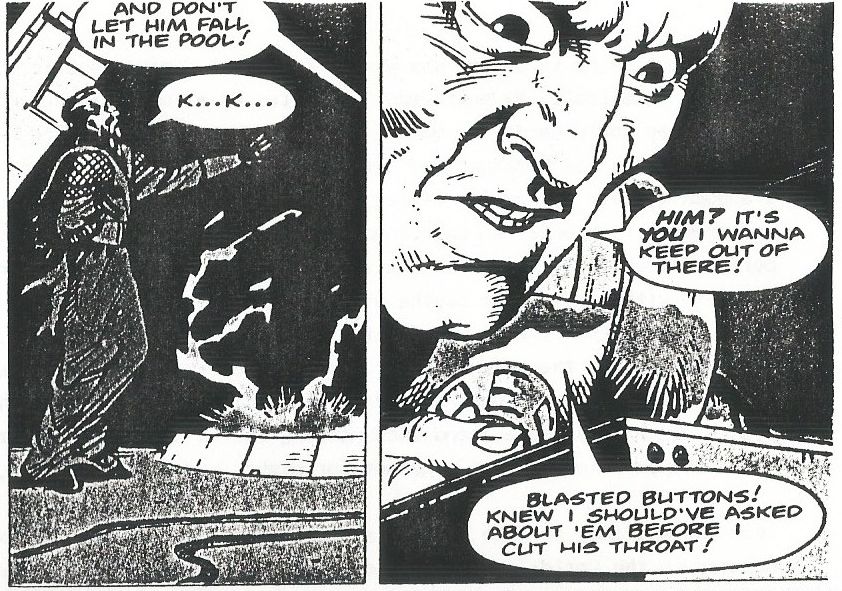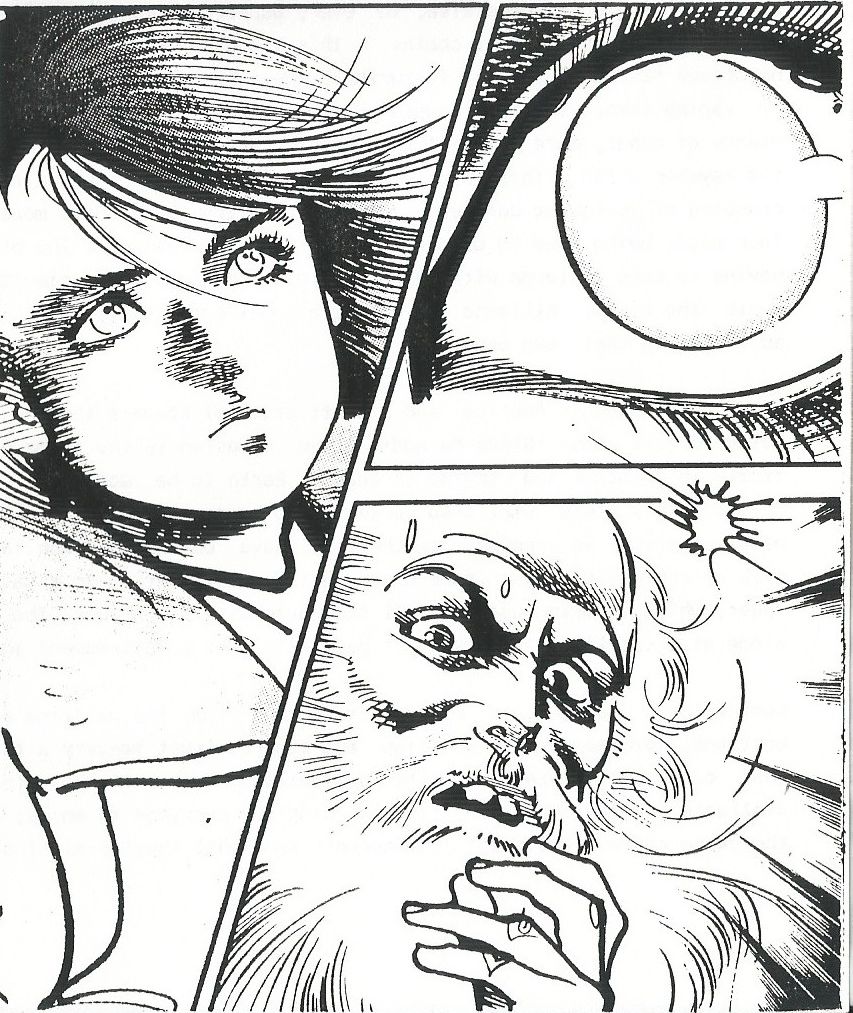The San Futuro Chronicles: Volume II
Unfortunately, due to circumstances beyond Steve’s control (like his PC vanishing without a trace), we are unable to bring you the advertised edition of The San Futuro Chronicles. Instead, in it’s place, you get yours truly waffling on about his favourite comics in a little more detail than I had room for back in Issue 0 (copies now available, 50p, plug, plug).
Steve and I have a good few comic favourites in common. This isn’t all that odd, since it was Mr. Welburn who was really responsible for nurturing the sapling of my vague interest into a full-scale hobby, and another pit into which to pour far too much money, by lending me large chunks of his collection. However, there are some noticeable exceptions and it’s these I’ll concentrate on in the main.

The first comic book I ever bought as an adult was when I was on holiday one summer in France. The French have a far better attitude than us to ‘bande dessinee’ as they call them – in the UK, comics are only just beginning to crawl out of the ghetto of Marvel superheroes and Biffo the Bear, where they’d been languishing, but in France, comics are accepted as valid adult literature. This means that they cover a wide range of topics – this can be slightly disconcerting to the British reader, used to escapist fantasy. However, the book I bought was a ‘comic’ in the true sense that it was funny. “Natacha l’hotesse d’air” caught my eye initially because of it’s title, but beyond that is a great read, even with my limited (and dictionary boosted) French.
Beyond being about the eponymous heroine, the books have little in common – she can be fighting head-hunters, digging for religious relics or getting kidnapped. The only other constancy is her modesty – due to their adult appeal mentioned above, French comics are a lot more graphic, especially in terms of sex, than we are used to. Yet Natacha always keeps her clothes on – something parodied superbly in “Nathalie, le petit hotesse”, a Dutch satire which has her engaging in virtually every sexual antic conceivable. Other French strips are just as good; Moebius is the best known artist, but no matter who draws them, they’re all a great way to brush up your French!
It was after this that I was loaned Steve’s collection, and the one that really caught my eye was “Hellblazer”. Despite having suffered a title change due to a certain Clive Barker film, this one is a continual barrage of interesting ideas. Steve gave you details last time, so I’ll pass on quickly, adding only that Issue 3 is probably my favourite single issue of any comic, and that after a worrying spell when the hero, John Constantine, was in danger of becoming a hippy, he is now back to his normal style and the two most recent issues have returned to their old, grim ways!

The obvious thing to do now was wander round the comic shops for myself and see what else was available. My next two favourites were both discovered about this time, though they could hardly be more different. “Laser Eraser & Pressbutton” (above, aka “Axel Pressbutton”) is perhaps the series I enjoy most, and is highly recommended to trashophiles for its mix of sex, violence and humour. Axel used to be a mild- mannered florist until an unfortunate encounter with a carnivorous, though extremely polite, plant left him with half a body. The surgeons fashioned a replacement, complete with a titanium scythe attachment and a button plugged directly into his pleasure centres to make up for the loss of his family jewels – hence his name. Mysta Mystralis, the Laser Eraser, is a cloned assassin with a penchant for tight- fitting costumes and together, they roam the galaxy ‘killing things’ (especially plants, in Axel’s case) and encountering weird creatures such as Zirk. He/It’s a melon-shaped alien with a penchant for bimbos and avocado puree, simultaneously…
From the sublime, to the just as sublime. The Japanese are THE most comic-oriented country in the world; everyone reads them, watches film versions of them and absorbs them, willingly or otherwise, in every aspect of life. As in France, the adult market has demanded adult comics – this has been taken to extremes in the highly notorious “Rapeman” series, featuring a super-hero who cures women’s sexual hang-ups by raping them. This has, unsurprisingly, not yet been translated into English. Plenty of other, more pleasant ones have – the best of which in my opinion is “Mai, the Psychic Girl” (below). This is a very visual comic, which may explain it’s successful crossing of language barriers – this one relies on visuals more than texts, with four pages being used to describe a car-crash for example. The plot is about a girl having to come to terms with her telekinetic powers, while simultaneously trying to avoid the Wisdom Alliance, an international conspiracy, who wish to subvert her abilities to their own ends.

From there, back to America and a swift steal of Steve’s thunder, as I know he was going to talk about ‘Slash Maraud’ (top). Alien invasion is the theme here, with the ET’s firmly in control and trying to change Earth to be more like their home planet. Unfortunately, this will also cause it to become uninhabitable by Earthlings, but nearly everyone is resigned to the fact, save our hero, Slash. He, and his motley crew of society’s dregs, take on the aliens, culminating in a battle at the Eiffel Tower, which is being used to fill the Earth with alien junk. The whole thing shoots along at a dazzling, lickety-split pace with not a dull moment in the six episodes.
Comics, as a whole, stand midway between the film, the painting and the book – the best ones combine pure imagination and superb visual imagery with evocative writing that can almost stand on it’s own, without any pictures. The range of comics available ensures that there is something for everyone to enjoy; anyone who writes the genre off as ‘childish’ just doesn’t know what they’re missing!